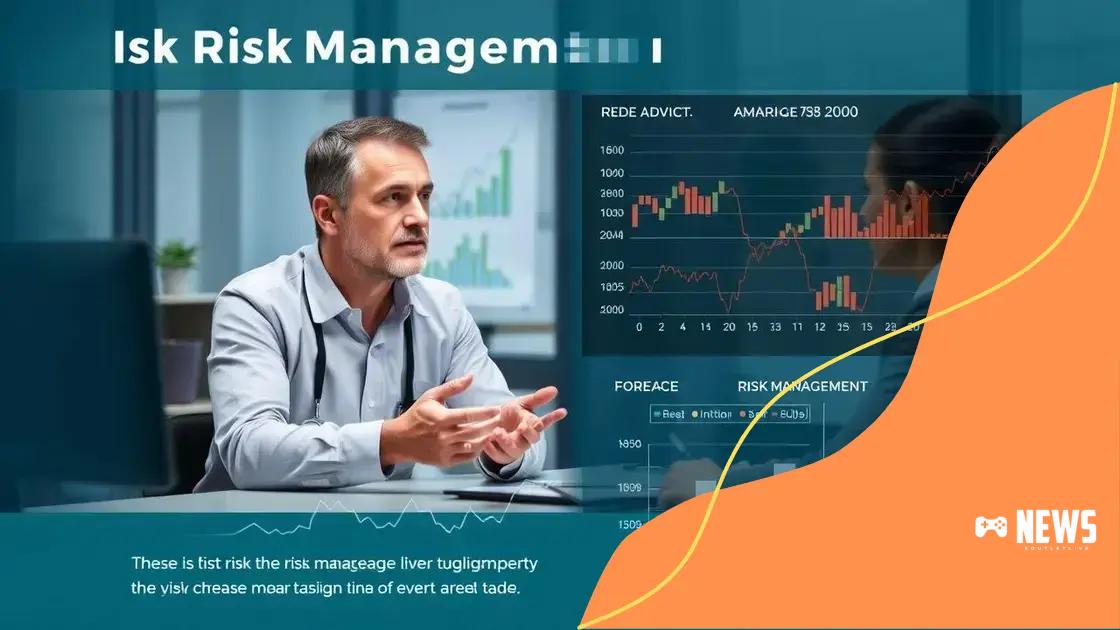Investment strategies amid trade policies: what to know

Investment strategies amid trade policies require awareness of global economic trends, effective risk management, and utilization of analytical tools to navigate fluctuations and protect assets.
Investment strategies amid trade policies play a vital role for investors looking to thrive in a fluctuating market. Have you considered how trade regulations might affect your portfolio? Let’s dive into effective strategies that help you adapt and grow.
Understanding trade policies and their impact on investments
Understanding trade policies is essential for investors navigating the financial landscape. These policies can influence market dynamics, affecting the potential for profit and risk. Let’s explore how trade regulations shape investment decisions.
Impact of Trade Policies
Trade policies can affect various sectors differently. For example, tariffs might increase costs, while trade agreements can open new markets. Investors need to stay informed about these changes.
When a government changes its trade stance, it can lead to shifts in stock values. Companies that rely on imports might see their costs rise, which could impact their profitability. On the flip side, businesses that export can benefit from favorable trade agreements, leading to increased sales.
Key Considerations for Investors
When evaluating investments in the context of trade policies, consider these factors:
- Global economic conditions
- Sector-specific regulations
- Currency fluctuations
- Political stability in trading partners
Each of these elements can influence the success of your investment strategy. For instance, changes in currency value can affect international sales, thus impacting profits for exporters.
Be proactive in monitoring trade policy changes and analyze their potential effects. Adjust your investment strategy accordingly to optimize returns and manage risks effectively.
Key investment strategies to consider
When considering investment strategies, it’s crucial to evaluate options that align with your financial goals. Key investment strategies can help you navigate the market changes brought on by evolving trade policies.
Diversification
Diversification is one of the most effective strategies. By spreading your investments across various asset classes, you reduce the overall risk. This means that when one investment performs poorly, others may do well, balancing your portfolio.
- Invest in stocks, bonds, and real estate.
- Consider international stocks for broader exposure.
- Use index funds to simplify diversification.
Another important aspect is the consideration of your risk tolerance. Knowing how much risk you are willing to take can guide you in selecting investments that suit your comfort level.
Investing in Value Stocks
Investing in value stocks is a strategy that focuses on acquiring undervalued companies. These companies may have solid fundamentals but are currently priced low due to market conditions.
In addition to value stocks, consider sectors that benefit from favorable trade policies. For example, industries that thrive on exports may see growth as barriers decrease.
Monitoring Economic Indicators
Keeping an eye on economic indicators also plays a vital role in shaping investment strategies. Tracking inflation rates, unemployment figures, and GDP growth can provide insight into market trends. Use this information to make informed decisions about when to buy or sell.
As you implement these strategies, regularly review and adjust your portfolio. This will help you stay aligned with market trends and trade policies that impact your investments.
Risk management in a changing trade environment

Risk management in a changing trade environment is essential for protecting your investments. As trade policies evolve, they can create uncertainties that impact financial markets. Understanding these risks helps you develop effective strategies.
Identifying Potential Risks
To manage risks effectively, start by identifying potential threats that can arise from trade policy changes. Changes in tariffs, regulations, or international agreements can directly affect your investments. Recognizing these factors early allows you to adjust your strategy accordingly.
- Monitoring trade agreements that could impact your sectors.
- Being aware of economic sanctions that could affect certain markets.
- Recognizing changes in demand for goods due to policy shifts.
By staying informed, you can avoid pitfalls and seize opportunities that arise amid volatility.
Diversification as a Strategy
Diversification is one key strategy in risk management. By investing in various asset classes, you can spread your risk. For example, allocate your investments across stocks, bonds, and real estate. This way, if one area suffers due to trade policy changes, others can perform well and stabilize your portfolio.
Additionally, consider geographic diversification. Investing in different countries can help mitigate risks from local events or changes in trade policies. This broader approach provides a cushion against shocks from any single market.
Utilizing Financial Instruments
Another way to manage risk in changing trade environments is by using financial instruments. Options and futures contracts allow investors to hedge against potential losses. For instance, if you anticipate a downturn in a sector due to new tariffs, you can use these tools to protect your investments.
Regularly reviewing your portfolio is also crucial. Make adjustments based on the latest trends, economic indicators, and world events. Being proactive in your risk management approach can help you navigate the complexities of a changing trade environment.
Analyzing global economic trends
Analyzing global economic trends is vital for informed investment decisions. By understanding these trends, investors can foresee potential opportunities and challenges in the market. Global economic trends shed light on how trade policies can affect various sectors.
Importance of Economic Indicators
Economic indicators are key to understanding the global landscape. They provide insights into the overall health of economies. Some important indicators include GDP growth, unemployment rates, and inflation.
- Gross Domestic Product (GDP): A rising GDP usually signifies a healthy economy.
- Inflation Rate: High inflation can decrease purchasing power.
- Unemployment Rate: Increasing unemployment often signals economic distress.
By keeping an eye on these indicators, you can make better investment choices based on expected market conditions.
Identifying Leading and Lagging Indicators
In addition to basic indicators, distinguishing between leading and lagging indicators can be beneficial. Leading indicators can forecast future trends, while lagging indicators confirm what has already happened. Examples of leading indicators include stock market trends and manufacturing activity, while lagging indicators cover employment data and corporate profits.
Understanding these patterns helps investors anticipate changes in the market, adapting their strategies accordingly. It also plays a significant role in recognizing the implications of trade policies on different economies. For instance, a trade deal between major countries can positively impact their GDP growth and, in turn, influence investor confidence.
Furthermore, investors should consider how global events affect economic trends. Factors like political unrest, natural disasters, or technological advancements can disrupt markets quickly. Keeping up with news will help you understand these shifts and adjust your investment strategy in real time.
Tools for better investment decision-making
Tools for better investment decision-making are essential for navigating today’s complex financial landscape. With so many variables, having the right resources can enhance your ability to make informed choices. Using technology and data analytics can provide valuable insights into market trends and potential investments.
Data Analysis Software
Data analysis software helps investors examine market data effectively. By using these tools, you can track trends and make projections based on historical data.
- Excel: A versatile tool for organizing data, performing calculations, and creating graphs.
- Tableau: A powerful visualization tool that makes it easy to interpret complex datasets.
- Bloomberg Terminal: A widely used platform for real-time data and analytics in financial markets.
These applications allow you to visualize trends and identify patterns that inform your investment strategies.
Stock Screeners
Stock screeners are helpful for filtering investments based on specific criteria. By setting parameters like price, market cap, or dividend yield, you can quickly narrow down your options.
Using a stock screener, you can find potential investments that align with your financial goals. It saves time and ensures that you focus on stocks that meet your requirements.
Investment Research Platforms
Research platforms, such as Morningstar or Seeking Alpha, provide comprehensive analysis and insights into various securities. They offer data on mutual funds, ETFs, and stocks.
These resources often include expert opinions and ratings, helping you assess the value and potential of your investments. Staying updated with expert commentary ensures that you’re aware of market shifts and opportunities.
Incorporating these tools into your investment process can lead to more informed decisions. Proper analysis and research will help you navigate the challenges of investing, especially in a changing environment influenced by trade policies.
FAQ – Frequently Asked Questions about Investment Strategies amid Trade Policies
What are the key tools for analyzing market trends?
Key tools include data analysis software like Excel and Tableau, stock screeners for filtering investments, and investment research platforms such as Morningstar and Seeking Alpha.
How can diversification protect my investments?
Diversification spreads your investments across various asset classes, which reduces risk. If one asset underperforms, others may perform well, balancing your overall portfolio.
What economic indicators should I monitor for investment decisions?
Key economic indicators include GDP growth, inflation rates, and unemployment figures. These provide insights into market conditions and help inform investment strategies.
Why is risk management important in investment?
Risk management helps you identify and mitigate potential losses. By understanding and preparing for market volatility, you can adapt your strategies and protect your investments.





